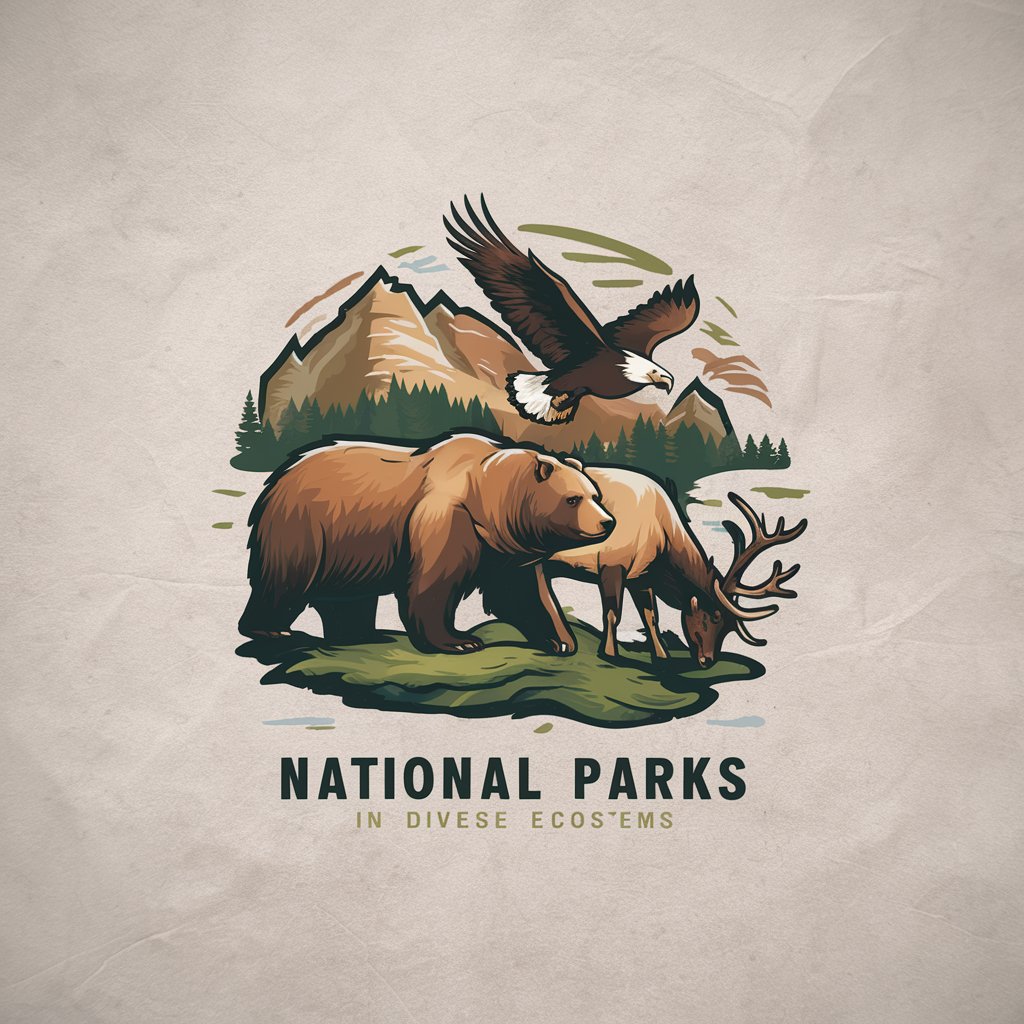National Parks - National Parks Guide

Explore the beauty of national parks with me—your guide to nature’s wonders.
Explore Nature with AI
Tell me about the wildlife unique to [National Park].
What are the most scenic trails in [National Park]?
Describe the geological features of [National Park].
What is the best time of year to visit [National Park]?
Get Embed Code
Understanding National Parks
National Parks are designated areas recognized for their natural beauty, ecological value, and cultural significance. They are established to preserve the integrity of their landscapes and ecosystems, allowing future generations to enjoy and learn from these natural wonders. These parks serve various purposes, including protecting biodiversity, supporting research and education, and providing recreational opportunities. For instance, Yellowstone National Park in the United States, the world's first national park, was established in 1872 to protect its vast array of geothermal features, like geysers and hot springs, as well as to preserve its extraordinary wildlife and rugged beauty. Another example is the Serengeti National Park in Tanzania, renowned for its annual wildebeest migration, showcasing the park's role in conserving natural animal behaviors and habitats. Powered by ChatGPT-4o。

The Core Functions of National Parks
Conservation
Example
Protecting biodiversity and natural habitats
Scenario
In Galápagos National Park, Ecuador, conservation efforts are crucial for protecting unique species like the Galápagos tortoise and marine iguanas, highlighting the park's role in preserving rare ecosystems.
Recreation
Example
Providing outdoor activities for visitors
Scenario
Yosemite National Park offers hiking, camping, and rock climbing, catering to outdoor enthusiasts while emphasizing low-impact and sustainable tourism practices.
Education
Example
Offering educational programs about nature and conservation
Scenario
Great Smoky Mountains National Park conducts programs and workshops on the region's biodiversity and history, fostering a deeper understanding and appreciation among visitors.
Research
Example
Supporting scientific studies on ecosystems, climate change, and wildlife
Scenario
Kruger National Park in South Africa provides a base for research on African wildlife, contributing to global knowledge on species conservation and ecosystem management.
Who Benefits from National Parks
Nature Enthusiasts and Outdoor Adventurers
Individuals who enjoy exploring the outdoors, hiking, wildlife watching, and participating in environmental education. They benefit from the well-preserved natural settings and the array of activities that national parks offer.
Conservationists and Environmentalists
Professionals and volunteers focused on environmental protection, biodiversity conservation, and sustainable living practices. National parks provide them with critical areas for research, conservation projects, and platforms for advocacy.
Educators and Students
This group utilizes national parks as dynamic, real-world classrooms for learning about ecology, geology, history, and environmental science, benefiting from the parks' resources for both informal and formal education programs.
Researchers and Scientists
Experts studying environmental patterns, wildlife behaviors, and ecological dynamics. National parks offer them unparalleled access to natural laboratories for conducting vital research that can influence global conservation strategies.

How to Use National Parks
Initiate Exploration
Begin your adventure by registering for a trial at yeschat.ai, offering immediate access without the need for login or subscription to premium services.
Plan Your Visit
Identify the national park you wish to visit. Consider factors like location, attractions, season, and park amenities. Utilize official park websites and resources for up-to-date information.
Prepare Accordingly
Gather necessary gear based on your activities (hiking, camping, wildlife viewing) and the season. Check the park's rules and regulations to ensure a safe and respectful visit.
Engage with Nature
Once there, engage in available activities that align with your interests, such as guided tours, hiking, or photography. Always adhere to Leave No Trace principles to minimize your impact.
Reflect and Share
After your visit, take time to reflect on your experience. Share your stories and photos with friends or through social media to inspire others while promoting conservation.
Try other advanced and practical GPTs
Rookie Rise
Craft Your Basketball Legacy

Basketball
Dive deep into the game with AI-powered basketball analysis.

Violin
Discover the artistry of violins with AI

🎶 Musical Dialogue Composer lv3.6
Turning dialogues into melodies with AI.

Experience League Helper
AI-powered Adobe learning and support assistant

League of Legends Buddy
AI-Powered LoL Gameplay Enhancer

College Basketball
Empowering your basketball knowledge with AI

Rédacteur Allo Paradise Plus
Empowering Gaming Content with AI

Logo Designer
Craft Your Brand's Identity with AI

Estate Insight Pro
Empowering Real Estate Decisions with AI

Shower Thoughts
Spark Creativity with AI-Powered Reflections

Tuskegee University Virtual Advisor
AI-powered guidance for Tuskegee studies

National Parks Q&A
What is the best time of year to visit National Parks?
The best time to visit National Parks varies by location and desired activities. Spring and fall often offer mild weather and fewer crowds, while summer is popular for its full range of activities despite larger crowds. Winter can provide unique experiences like snowshoeing or solitude in parks known for their winter landscapes.
Can I volunteer at a National Park?
Yes, many National Parks offer volunteer programs ranging from trail maintenance to educational outreach. These programs provide a way to give back to the parks, gain unique insights, and sometimes earn benefits like free camping. Check the National Park Service's website for opportunities.
What are some tips for wildlife viewing in National Parks?
For wildlife viewing, visit during dawn or dusk when animals are most active. Keep a safe distance, use binoculars or a zoom lens for closer views, and stay quiet to avoid disturbing them. Always follow park guidelines to protect both yourself and the wildlife.
Are National Parks accessible for people with disabilities?
National Parks strive to be accessible to everyone. Many have paved trails, accessible visitor centers, and programs designed to accommodate visitors with disabilities. It's recommended to check the specific park's website or contact them directly for information on accessible features.
How can I minimize my impact while visiting National Parks?
Minimize impact by staying on marked trails, packing out all trash, respecting wildlife from a distance, and avoiding the removal of natural objects. Use established campsites, and consider visiting less crowded parks or areas to reduce wear on popular sites.
